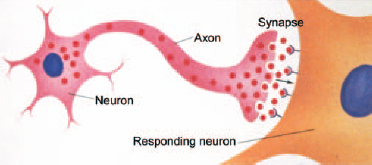Nervous SystemNeuron Function |
What is an action potential? |
An action potential is a series of rapidly occurring events that locally decrease and reverse the membrane potential and then eventually restore it to the resting state. The two phases of an action potential are the depolarizing phase and the repolarizing phase. During the depolarizing phase, the inside of the neuron becomes more positive than the outside, reaching 30 millivolts. During the repolarizing phase, the membrane polarization is restored to its resting state of –70 millivolts. The depolarizing and repolarizing phases of an action potential last approximately one millisecond.
The production of the action potential by the opening of a special ion channel in the cell membrane was first described by Alan Lloyd Hodgkin (1914–1998) and Andrew Fielding Huxley (1917-) in the 1940s. They shared the Nobel Prize in Physiology or Medicine in 1963, along with Sir John Eccles (1903–1997), for their discoveries concerning the ionic mechanisms of the action potential and the excitation and inhibition of the nerve cell membrane.

